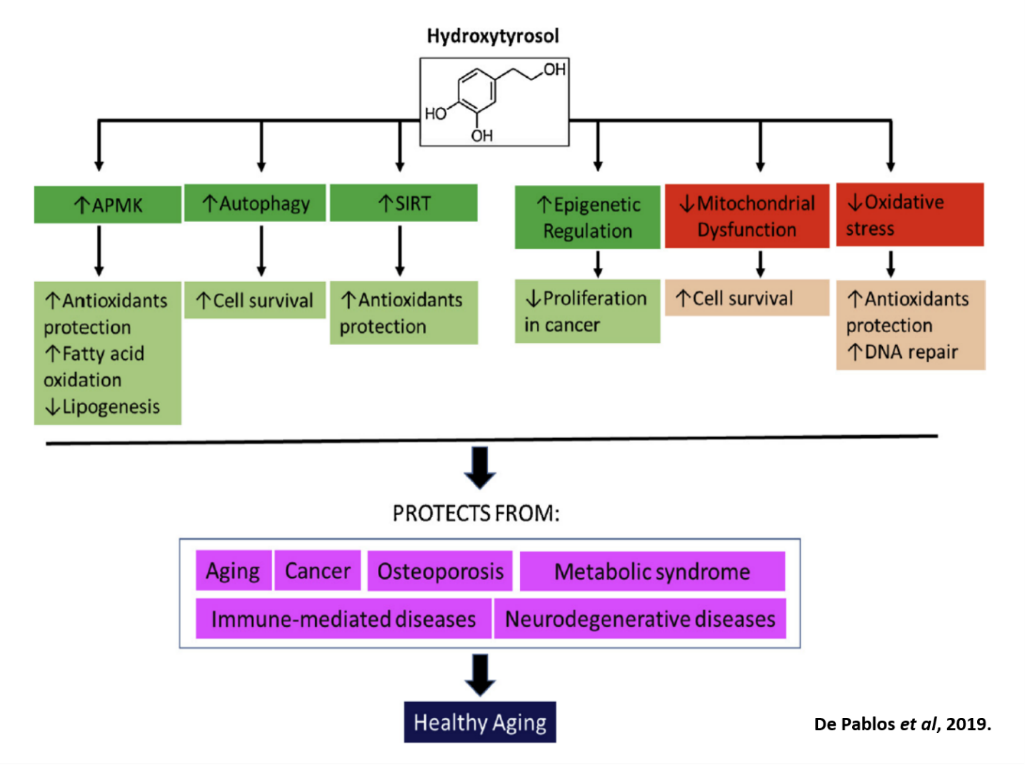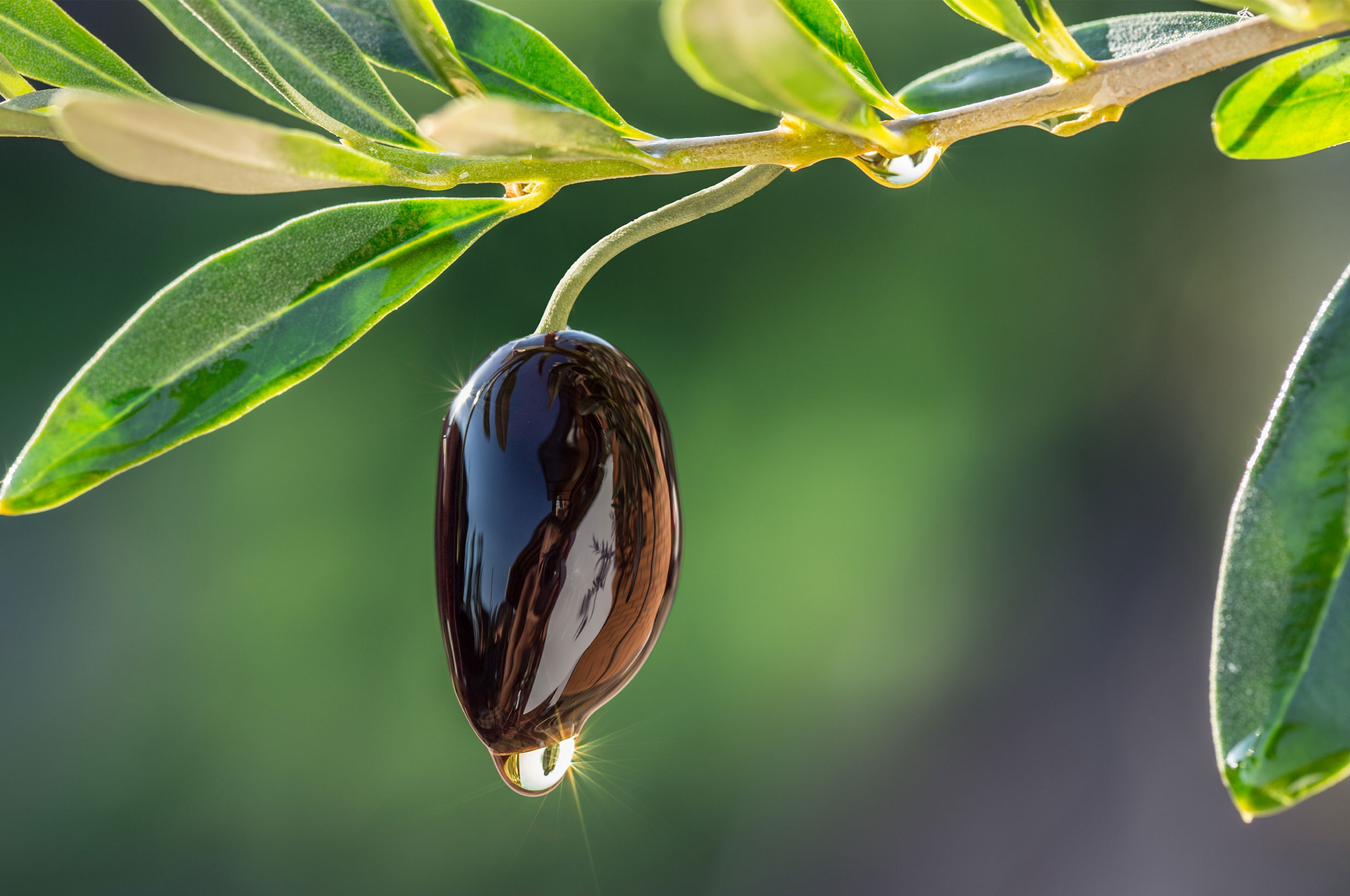What would I consider the most important evidence-supported food for healthy longevity? 11 years ago, in 2010, a scientist working in cancer research hypothesized that the many health benefits of olive polyphenols could come from an impact on the mechanisms of aging. This statement even prevented an American company from obtaining a patent. The science of aging, as we know it today, was beginning to define the involvement of related metabolic pathways, now referred to as “primary aging“.
At the time, this hypothesis attempted to explain why olive polyphenols have such varied health benefits. They accumulate evidence for cardiovascular disease, cancer, osteoporosis, neurodegenerative diseases, inflammatory processes, metabolic syndrome and type II diabetes. The last ten years have proven this scientist to be true by allowing the identification of mechanisms of action linked to the aging process.
The great family of polyphenols
Plant polyphenols constitute a large family of more than 10,000 molecules with various beneficial effects. Coming from different origins, polyphenols have, among other things, antioxidant and anti-inflammatory impacts, cardiovascular benefits, preventive effects on cancer and, for some, anti-aging effects. The beneficial molecules of plants very often come from polyphenols, which include flavonoids (e.g., anthocyanins), stilbenes (e.g., resveratrol), lignans (e.g., secoisolariciresinol from flax), phenolic acids (e.g., caffeic acid) and coumarins (the source of the anticoagulant drug of the same name).
One would think that the multiple health benefits of olive oil are related to its high composition of monounsaturated fatty acids (MUFAs), particularly oleic acid. However, many vegetable oils rich in monounsaturated fatty acids do not provide the same health benefits as olive oil (sunflower, soy and canola oil). It is the phenolic fraction, the polyphenols, of olive oil that is believed to be largely responsible for the multiple health benefits of this oil. Studies have even shown a direct correlation between certain health benefits and the amount of polyphenols present in the oil (cardiovascular health). Since polyphenols are soluble in water, not oil, some oils contain barely any. We will come back to this.
Olives; cultivated since the time of the pharaohs
Olives come from a small tree called the olive tree (family Oleaceae). Although they are now found in different regions of the world, the Mediterranean Sea basin accounts for 98% of world olive production. Olive oil is the main source of fat in the Mediterranean diet. Olives have been cultivated for over 7,000 years. The Egyptians of Ancient Egypt used the leaves to mummify the pharaohs. The health benefits of olives are due to the composition of its oil (mainly monounsaturated) and the presence of certain nutrients: tocopherols, carotenoids, phospholipids and polyphenols. There are more than 30 different types of polyphenols, the concentrations of which depend on the type of cultivar, its production area, the method of extraction as well as the ripeness of the fruit. There are believed to be around 2,500 varieties of olives, of which, 250 are believed to be cultivated. Spain is currently the largest producer, followed by Italy and Greece.
Hydroxytyrosol as a gerosuppressive agent
During the 2000s, several studies had made it possible to establish the link between the concentration of certain polyphenols and health benefits. The most important olive polyphenols, in terms of quantity and demonstrated benefit, are hydroxytyrosol and tyrosol. Due to its high bioavailability, stability and multiple health benefits, hydroxytyrosol is now the most studied polyphenol. Mechanisms of action have recently been added to breast cancer, bone density, chondrocytes, fibromyalgia and even in results towards fighting SARS-Cov2.
It was in 2013 that a first group of Spanish scientists proposed qualifying olive polyphenols as gerosuppressive agents; suppressants of aging. Six years later, de Pablos and collaborators (2019) carried out an impressive review of the literature on all the mechanisms of action, animal models and human clinical studies by claiming that hydroxytyrosol protects against aging via an impact on AMPK (a primary aging effector) and autophagy. Autophagy is a self-degradation process that recycles and/or destroys damaged cells or structures in order to keep cells more functional and prevent certain cases of cancer. It is a recycling process strongly linked to healthy longevity.
In addition to autophagy and the action on AMPK, hydroxytyrosol benefits from an action on sirtuins, epigenetic regulation, mitochondrial health and oxidative stress.

The effective dose
One of the most interesting pieces of information when it comes to health benefits is the effective dose; the dose required to provide a significant benefit. A claim is permitted in Europe for the consumption of 5 mg of hydroxytyrosol and its derivatives. The EFSA (European Food Safety Authority) concluded that there is a well-established cause and effect relationship and that the consumption of olive oil polyphenols provides a significant health benefit for the general population (reduction in the risks of cardiovascular diseases by the decrease in the oxidation of bad cholesterol).
The clinical studies carried out, for various health benefits, have obtained positive results for doses mainly ranging from 1 to 15 mg of hydroxytyrosol per day for an adult. The question then arises: how much olive oil does this dose correspond to? Following the analysis of 430 commercial oils, a study reported polyphenol concentrations of 23 to 751 mg/kg.
This large variation is due to the types of olives used, their maturity during pressing, and whether the oil oxidizes or not. The amount of 5 mg of olive polyphenols corresponds to an amount of 7 to 217 grams of oil per day. For oils with a good content of olive polyphenols (dark oils with a pronounced pungent taste), this is considered a reasonable amount. This corresponds to the amount of olive oil consumed by people following the Mediterranean diet in Europe: 25 to 50 ml per day.
Continuous research
In addition to olive polyphenols, other plant molecules are currently being identified and being studied in order to obtain new gerosuppressive agents. As with olive polyphenols, some come from food (e.g., celery seed or fenugreek) and other plant extracts (e.g., white willow or valerian). Understanding their beneficial effects on cellular function, and above all, on healthy longevity, should give us new prevention intervention tools.
Originally published in the journal Vitalité QC: https://vitalitequebec-magazine.com/
References:
- Barzilai, et al, 2012. The rationale for delaying aging and the prevention of age-related diseases. Rambam Maimonides Med J. 2012 Oct 31;3(4)
- Bertelli M, Kiani AK, Paolacci S, Manara E, Kurti D, Dhuli K, Bushati V, Miertus J, Pangallo D, Baglivo M, Beccari T, Michelini S. Hydroxytyrosol: A natural compound with promising pharmacological activities. J Biotechnol. 2020 Feb 10;309:29-33.
- Calahorra J, Martínez-Lara E, Granadino-Roldán JM, Martí JM, Cañuelo A, Blanco S, Oliver FJ, Siles E. Crosstalk between hydroxytyrosol, a major olive oil phenol, and HIF-1 in MCF-7 breast cancer cells. Sci Rep. 2020 Apr 14;10(1):6361.
- Cicerale et al, 2010. Biological Activities of Phenolic Compounds Present in Virgin Olive Oil. Int J Mol Sci. 2010; 11(2): 458–479.
- de Pablos et al, 2019. Hydroxytyrosol protects from aging process via AMPK and autophagy; a review of its effects on cancer, metabolic syndrome, osteoporosis, immunemediated and neurodegenerative diseases. Pharmacological Research 143 (2019) 58–72.
- Ergoren MC, Paolacci S, Manara E, Dautaj A, Dhuli K, Anpilogov K, Camilleri G, Suer HK, Sayan M, Tuncel G, Sultanoglu N, Farronato M, Tartaglia GM, Dundar M, Farronato G, Gunsel IS, Bertelli M, Sanlidag T. A pilot study on the preventative potential of alpha-cyclodextrin and hydroxytyrosol against SARS-CoV-2 transmission. Acta Biomed. 2020 Nov 9;91(13-S):e2020022.
- Hano C, Tungmunnithum D. Plant Polyphenols, More than Just Simple Natural Antioxidants: Oxidative Stress, Aging and Age-Related Diseases. Medicines (Basel). 2020 May 9;7(5):26.
- Menendez et al, 2013. Xenohormetic and anti-aging activity of secoiridoid polyphenols present in extra virgin olive oil. A new family of gerosuppressant agents. Cell Cycle 12:4, 555–578; February 15, 2013.
- Peyrol et al, 2017. Hydroxytyrosol in the Prevention of the Metabolic Syndrome and Related Disorders. Nutrients 2017, 9, 306.
- Ramírez-Tejero JA, Martínez-Lara E, Peinado MÁ, Del Moral ML, Siles E. Hydroxytyrosol as a Promising Ally in the Treatment of Fibromyalgia. 2020 Aug 9;12(8):2386.






